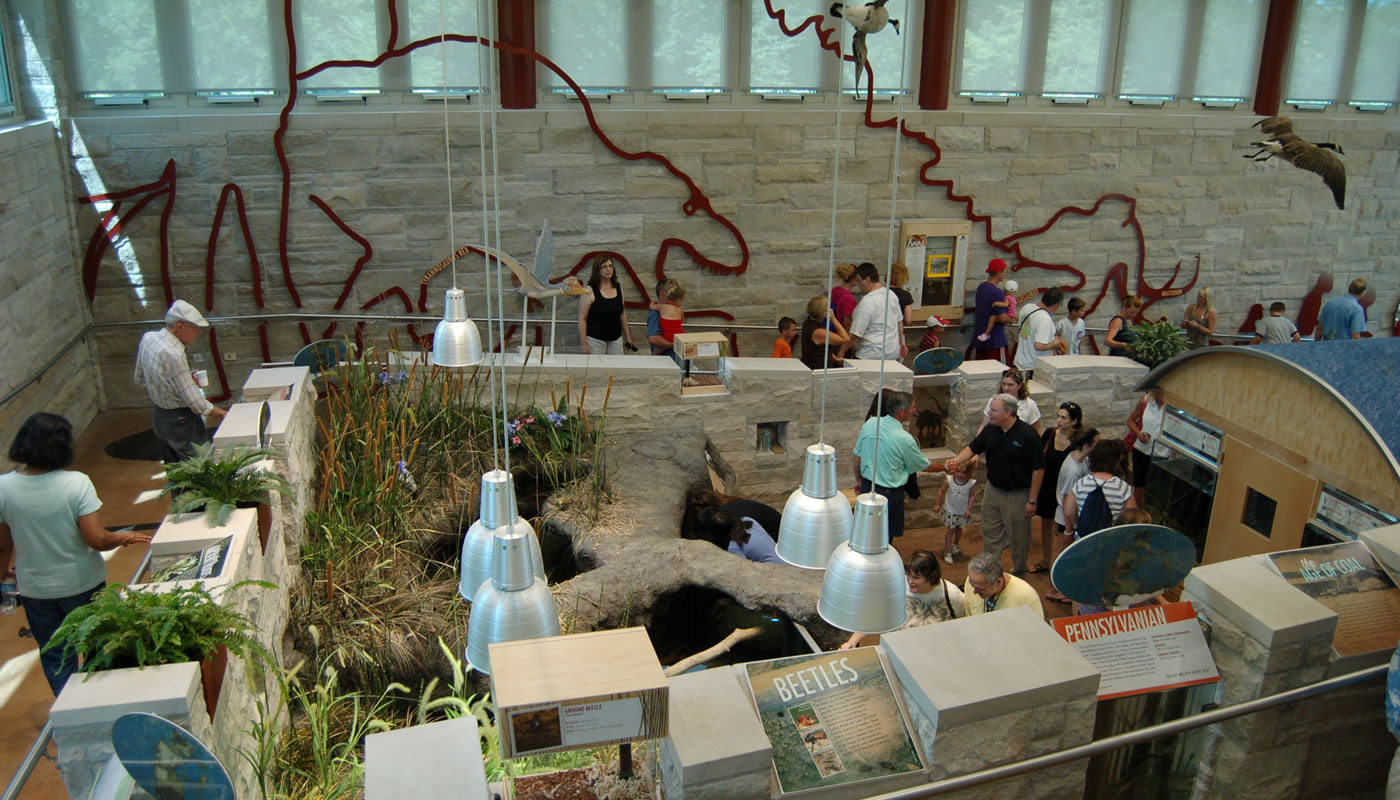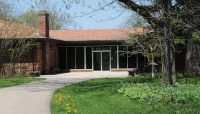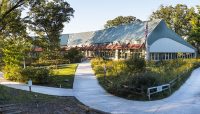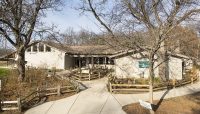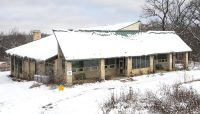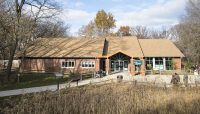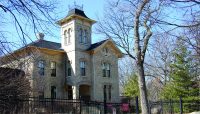The Forest Preserves’ nature centers provide a gateway for discovery of the natural diversity of Cook County. Each Nature Center offers programs and displays about the plants, animals and natural communities of the region.
On this page:
Locations

Educational Programs
Our hybrid learning and field trip offerings allow teachers, parents and youth leaders to use forest preserves and nature centers as an outdoor (or virtual) classroom. Our hybrid learning programs serve kindergarten through 12th grade students and meet Next Generation Science Standards (NGSS), while our field trips serve everyone from pre-K to adult learners.
Please contact experience.nature@cookcountyil.gov for more information or to discuss programs tailored to your learning objectives.
Hybrid Learning: Educational Adventures
Kindergarten – 12th Grade
These free science and nature programs feature hands-on activities and allow students to use critical thinking skills while connecting with local natural areas. Our programs meet Next Generation Science Standards (NGSS) for specific grade levels and can be tailored to your needs. Most programs combine learning that is led by Forest Preserves staff with teacher-led or independent classroom or at-home activities. Contact individual locations for more information:
- Crabtree Nature Center (Barrington) – 847-381-6592
- Little Red Schoolhouse Nature Center (Willow Springs) – 708-839-6897
- River Trail Nature Center (Northbrook) – 847-824-8360
- Sagawau Environmental Learning Center (Lemont) – 630-257-2045
- Sand Ridge Nature Center (South Holland) – 708-868-0606
- Trailside Museum of Natural History (River Forest) – 708-366-6530
- Other locations – experience.nature@cookcountyil.gov
Monarch Butterflies
Learn about migration by exploring the habits and adaptations of the monarch butterfly. Explore the Legend of the Monarch Butterfly with a coloring book. Learn about monarch butterflies and their importance in human culture.
- Grades: K-2
- NGSS:
- K-LS1-1, K-ESS3-2, K-ESS3.A
- 1-LS1-2, 1-LS1.D
- 2-LS2-1, 2-LS4
Recommendation: This program can be part of a series that includes virtual lessons led by Forest Preserves staff and teacher-led or independent classroom or at-home activities.
Animals in the Fall
Increase your interest and knowledge of animals that live in the Forest Preserves as we explore and investigate the different types of animal coverings, adaptations and animal activity in the fall.
- Grades: K-2
- NGSS:
- K-LS1.C, K-ESS3.C, K-ESS3.A
- 1-LS1, 1-LS1.A
- 2-LS2.A, 2-LS4.D, K-2-EST1.C
Recommendation: This program can be part of a series that includes virtual lessons led by Forest Preserves staff and teacher-led or independent classroom or at-home activities.
Birds on the Move (Migration)
Explore local birds and engage students as they learn about migration and why and how birds migrate in search of resources.
- Grades: K-2
- NGSS:
- K-LS1.C, K-ESS2.E & K-ESS3.C, K-ESS3.A & K-ESS3.C
- 1-LS1-2, 1-LS1.D
Recommendation: This program can be part of a series that includes virtual lessons led by Forest Preserves staff and teacher-led or independent classroom or at-home activities.
Acorn Hide and Seek: Red-headed Woodpeckers
This lesson introduces students to the red-headed woodpecker, including this bird’s ability to cache food to prepare for winter. This concept is reinforced with a hide-and-seek game students can play in their homes and/or yards.
- Grades: K-2
- NGSS:
- K-LS1-1, K-ESS2.E, K-ESS3.A
- 1-LS1.A
- 2-LS2.A, 2-LS4.D, K-2-EST1.C
Recommendation: This program can be part of a series that includes virtual lessons led by Forest Preserves staff and teacher-led or independent classroom or at-home activities.
Creature of the Night: Little Brown Bat
Explore the connection between bats and the fall/Halloween season. Learn about echolocation and how bats use it.
- Grades: K-2
- NGSS:
- K-LS1-1, K-LS1.C
- 1-LS1.A, 1-LS1.B
- 2-LS2-1, 2-LS4.D
Recommendation: This program can be part of a series that includes virtual lessons led by Forest Preserves staff and teacher-led or independent classroom or at-home activities.
Slow and Steady Wins the Race: Blanding’s Turtle
Children will be introduced to turtles and their lifecycle, learn what turtles need to survive and find out how humans can help.
- Grades: K-2
- NGSS:
- K-LS1-1, K-LS1.C
- 2-LS2-1, 2-LS4.D
Recommendation: This program can be part of a series that includes virtual lessons led by Forest Preserves staff and teacher-led or independent classroom or at-home activities.
Beaks, Feet and Feathers
Birds have special physical adaptations of beaks, feet and feathers, and behaviors that enable birds to exploit resources, survive and reproduce within the habitats they live in. Students will research and do activities that will explore bird adaptations and behavior.
- Grades: 3-5
- NGSS:
- 3-LS1-LS1.B, 3-LS2-LS2.D, 3-LS3-LS3.B, 3-LS4-LS4.C, LS4.B, LS4.D
- 4-LS1 – LS1.A, LS1.D
- 5-PS3 – LS1.C, 5-LS2 – LS2.A
Recommendation: This program can be part of a series that includes virtual lessons led by Forest Preserves staff and teacher-led or independent classroom or at-home activities.
Interesting Insects
Insects fill important roles as pollinators and as food for other insects and animals. Students will do activities that explore insect anatomy, habitats and adaptations.
- Grades: 3-5
- NGSS:
- 3-LS1.B, 3-LS2.D, 3-LS4.C, 3-LS4.D
Recommendation: This program can be part of a series that includes virtual lessons led by Forest Preserves staff and teacher-led or independent classroom or at-home activities.
Tremendous Trees
Tree growth and survival depends on both physical characteristics and environmental factors. Students will study the form and function of tree parts and learn how trees respond to changing temperature and moisture levels that define the seasons in our region.
- Grades: 3-5
- NGSS:
- LS1.B, 3-LS4, LS2.C, LS4.C, LS4.D
- 4LS.1, LS1.A
- 5-PS3: PS3.D, LS1.C, 5-LS1: LS1.C, 5-LS2, LS2.A
Recommendation: This program can be part of a series that includes virtual lessons led by Forest Preserves staff and teacher-led or independent classroom or at-home activities.
Habitats for Sale
For an animal to survive, it must be able to find a suitable habitat that provides four essential things: food, water, shelter and a place to raise their young. Students will research habitats found in Cook County and learn about the resources available for the animals that call them home.
- Grades: 6-8
- NGSS:
- MS-LS2-1
- MS-LS2.A
- MS-ETS1.b
Recommendation: This three-part program involves an introductory presentation led by Forest Preserves staff or a teacher, independent student research and a student group discussion that is facilitated by Forest Preserves staff.
Water Cycle
The hydrologic cycle, or water cycle, is one of the main cycles that allows for life on Earth. Students will learn how water changes its physical state and moves through the environment, and how the hydrologic cycle impacts life in different ecosystems.
- Grades: 6-8
- NGSS:
- MS-ESS2-4
Recommendation: This program can be facilitated virtually by Forest Preserves staff or a teacher.
Plant Field Guides
In this self-guided activity, students will explore nature in their neighborhood to learn more about plants and their adaptations. They will take their discoveries and use them to create a field guide for plants in their community.
- Grades: 9-12
- NGSS:
- HS-LS4-3
Recommendation: This is a student-led activity that can be supplemented with a teacher-led discussion and/or a facilitated virtual program by Forest Preserves staff.
Divided Communities & Unified Solutions
Students learn about a natural resource management topic (examples: deer overpopulation, zebra mussels) and how communities can address these issues using working groups. Students will roleplay a working group facing an environmental problem and work together to find a solution.
- Grades: 9-12
- NGSS:
- HS-LS2-7
Recommendation: This three-part program involves an introductory presentation led by Forest Preserves staff or a teacher, independent student research and a student group discussion that is facilitated by Forest Preserves staff.
Why Do Insects Visit Flowers? (Hint: It’s Not Always for Pollen)
Students make sense of what insects visit flowers in their neighborhood or on campus, and which parts of flowers these insects are visiting. They use structure and function as a thinking tool (cross-cutting concept) to connect the parts of the flower that are visited to function of these parts, and then make predictions about how insects adapt to floral resources and adaptations of flowers to attracting beneficial insects.
- Grades: 9-12
- NGSS:
- HS-LS2-2, HS-LS2-6, HS-LS2-8, HS-LS4-4
Recommendation: This stand-alone lab can be led by a teacher, students or Forest Preserves staff.
Using Topo Maps to Solve Problems
Students make sense of the phenomenon of changes in landscapes captured on a topographic map and use what they learned to explore their own location and inform decisions about appropriate human uses for different sites.
- Grades: 9-12
- NGSS:
- HS-ESS3-1, HS-ESS3-4
Recommendation: This is a student-led activity that can be supplemented with a teacher-led discussion and/or an in-person visit to a forest preserve.
Water is Life
Clean water is an essential component of life on Earth, including human life. Students will engage with the ecological meaning of “clean water” while exploring water testing methods, including benthic macroinvertebrate sampling (dip netting), fish surveying and water chemistry testing.
- Grades: 9-12
- NGSS:
- HS-LS2-2, LS2.C, HS-LS2-6, HS-ESS3-3, ESS3.C
Recommendation: A teacher or Forest Preserves staff member leads a presentation, then students analyze data collected by wildlife biologists, reflect via a teacher-facilitated discussion and then design their own inquiry.
Canyon Tour
Follow a naturalist back in time, from glaciers to ancient seas, on this visit to Cook County’s only rock canyon. Learn about the geology of northeastern Illinois and then infer how it influences everything from why certain plants grow here to where cemeteries are sited. Call Sagawau Environmental Learning Center at 630-257-2045 to learn more.
- Grades: 9-12
- NGSS:
- HS-ESS1-6, HS-ESS2-7, HS-ESS2-7, HS-LS4-4, HS-LS4-5
Recommendation: This activity requires a teacher-led introduction and discussion alongside a prerecorded video tour of Sagawau Canyon. A live video tour with a Forest Preserves staff-led discussion is also available.
Field Trips: Experiences in the Field at Forest Preserves
Pre-K – Adult Learning
Take your classroom outdoors with a visit to a local forest preserve or nature center. Forest Preserves staff provide engaging, hands-on field trips tailored to your learning objectives while connecting students to nature in their community.
Learn about the plants, animals and natural communities of the region by walking nature trails, meeting live ambassador animals or participating in field science labs—all guided by Forest Preserves staff and designed to drive inquiry back into your classroom.
We can host individualized programs for one hour or more depending on your curriculum goals and objectives. We also offer service learning and ecological stewardship service projects with education outcomes.
Please inquire about scheduling at least three weeks in advance, as calendars fill quickly. All programs are subject to limits of available staff and space. Contact individual locations for more information:
- Crabtree Nature Center (Barrington) – 847-381-6592
- Little Red Schoolhouse Nature Center (Willow Springs) – 708-839-6897
- River Trail Nature Center (Northbrook) – 847-824-8360
- Sagawau Environmental Learning Center (Lemont) – 630-257-2045
- Sand Ridge Nature Center (South Holland) – 708-868-0606
- Trailside Museum of Natural History (River Forest) – 708-366-6530
- Other locations – experience.nature@cookcountyil.gov
Education Access Permit
An Education Access Permit is required for all school/educational activities, such as class field trips, practices or other group education visits to a forest preserve or nature center, for all groups of 25 or more, and/or when requesting assistance from Forest Preserve staff. The Permit is granted for the day(s) of the field trip or activity. There is no fee for the Education Access Permit.
- Education Access Permit (PDF)
- Special Access Permit Waiver- Entity (PDF)
- Special Access Permit Waiver- Individual (PDF)
Volunteer Opportunities
Volunteer at Nature Center events and Ecological Stewardship Workdays.

